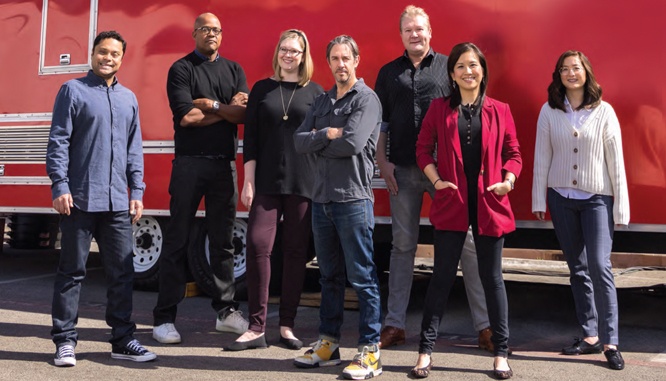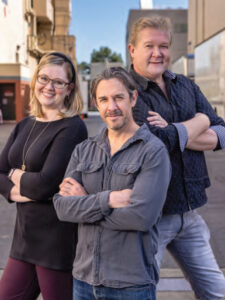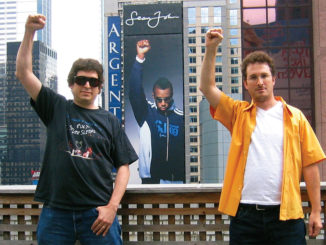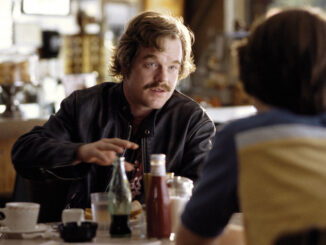
By Peter Tonguette
Every editor wants to help tell stories that millions of people will see.

For those who work in post-production, the long hours spent poring over dailies, collaborating with directors and producers, and making scenes just so are rewarded when audiences respond appreciatively. Happily, when picture editors work on a film or show in the Marvel Cinematic Universe, their chances are high of reaching a large number of enthusiastic viewers.
“I think all of us would agree that as hard as we work on these things, it’s almost like: a tree falls in the forest, does it matter?” said Terel Gibson, ACE, one of three picture editors to work on one of the latest and most distinctive offerings in the MCU, Marvel Studios’ limited series “Hawkeye.” “You know when you’re making a Marvel show that it’s going to reach the widest possible audience. That’s incredibly exciting.”
The six-episode limited series, which premiered on Disney+ on Nov. 24, stars Jeremy Renner as Hawkeye, the maestro of marksmanship formerly affiliated with the Avengers. In a story that unfolds in New York during Christmastime, Hawkeye, also known as Clint Barton, finds his holiday season curtailed when an aspirant superhero, the Hawkeye-worshiping but eminently skillful in her own right Kate Bishop (Hailee Steinfeld), enters his orbit. The series might be considered a Christmas MCU show in the same way that “Die Hard” is a Christmas action movie, and the result resonated with audiences.
‘The show is like a rollercoaster.’
“Who doesn’t love Christmas? I think that’s just such a wonderful vibe going in,” said picture editor Rosanne Tan, ACE. “We all kind of go down the rabbit holes on Twitter or YouTube, just checking the views of people checking the trailers. It’s just amazing: millions of views within hours.”
But it wasn’t just diehard MCU fans who responded to the series, which offered both the usual MCU-style action as well as an emotional through-line that suggested nothing so much as a holiday classic on the order of, say, John Hughes’s classic 1987 comedy-drama “Planes, Trains and Automobiles.” Consequently, MCU novices took notice, too.
“I watched it over Thanksgiving with the family — with my mother-in-law and my brother-in-law and some of the family,” Gibson said. “What’s interesting is how well it played, particularly for my mother-in-law, who has probably seen two Marvel movies in her entire life. To see it play as well as it did for her was really nice. . . . There’s enough for people that know it inside and out, and there’s also enough for people that are coming in relatively cold.”
Yet it wasn’t just the show’s unusual tone and backdrop that represented a risk. At the center of “Hawkeye” is not only one of the MCU’s lesser-known Avengers but a character making her first appearance in the MCU, Kate Bishop. That represented a double challenge for the post-production team.
“We have this interesting format where basically we’re introducing a new character in a show called ‘Hawkeye,’ and let’s be clear that Hawkeye may not be everybody’s favorite Avenger,” Gibson said. “You’re creating almost two levels of firewall of resistance between the audience. Meaning, it’s about Hawkeye: ‘Who’s that? The bow-and-arrow guy? OK, cool.’ But also we have this direction where we’re very much focused on introducing a new character to the MCU. . . . Just the idea of getting to a place where people are embracing this new character with open arms is certainly the thing I’m most proud of.”

Not that the character of Hawkeye/Clint Barton lacked for fans among the editors. Tan, who previously worked on the Disney+ MCU series “The Falcon and the Winter Soldier,” jumped at the chance to leap into the mind of a character whose backstory had only been sketched in previous entries in the MCU.
“I actually really like Hawkeye, and just from watching all the movies, he was a character that I wish we got to explore more,” said Tan. (Renner had appeared as Hawkeye/Barton in numerous previous MCU movies, including “The Avengers” [2012], “Avengers: Age of Ultron” [2015], and “Avengers: Endgame” [2019].) Tan, who was excited at the idea of “spending six mini-movies kind of exploring his character,” was also intrigued with the possibilities of exploring the dynamic between Hawkeye/Barton and Bishop: “I thought this was interesting — having a mentor/mentee type of approach to a story,” she said.
Added Gibson: “I think that’s very much to Marvel’s credit that they’re exploring these little corners of the universe that are connected, but there’s a light interconnection.”
The visual effects were a challenge. ‘It was just a lot of stress.’
For the editors, another big part of the appeal was the Christmas setting. Tim Roche, ACE, who most recently worked on the Disney+ MCU series “WandaVision,” praised Marvel Studios for making each of its shows and movies feel different while remaining true to the overall universe. “There’s a similar language and a similar sort of tone that they share in a lot of ways, but this was just so different,” Roche said. “Set in New York City, much more gritty, but also a Christmas series.” The team kept returning to that idea as their North Star, Roche said. “This is a Christmas movie,” he said. “This is fun. Let’s have fun with it.” The 1990 Hughes family comedy “Home Alone” was a constant point of reference in terms of tone, he added.
Of course, “Hawkeye” isn’t all about jokes and good cheer. At the heart of it all is the central relationship between Hawkeye/Barton and Bishop. “It is kind of like a ‘Midnight Run’ in the sense that they start out, Jeremy doesn’t want to have anything to do with [Bishop] — he just wants to get home to his family,” Roche said. “Then they sort of build a relationship over those six episodes to: ‘Of course you can’t leave her.’ He sees something in her. I feel that we did a good job of feeding their relationship, the conflict in it, and then resolving it in a good way.”
In the course of their adventures, Hawkeye/Barton and Bishop encounter all manner of nemeses. “You’ve got a lot of actors, you’ve got a lot of balls in the air,” Gibson said. “Ultimately, I think the architecture of the show is almost like a rollercoaster that you keep adding passengers to. As we go up, we add a Yelena [Florence Pugh], we add a Maya [Alaqua Cox].”
Helping to anchor the series was the presence of Steinfeld, who received an Oscar nomination for her performance in
he Coen Brothers’ remake of “True Grit” (2010). “She’s just an insane talent. You knew that if you had her planted in the center of any situation or scene, she would always guide you through,” Gibson said. “She could always find something. She’s an amazing listener.”
The picture editors, who had not previously worked together, found that they were good listeners, too. “We’re always showing each other things,” Tan said. “When we bring in new music cues or something, we tell each other about it.” During a year-long post-production process that featured a hybrid of in-person and virtual editing, the communication lines between the editors were always open. “We were able to be in-person and go to each other’s rooms and show each other things, and then even when we were remote, I would send PIX links to Terel and Tim,” Tan said.

Added Roche: “I can’t say enough about Terel and Rosie. . . . We were always on the same page in terms of trying to get things done, helping each other out. I never felt shy about pitching an idea or even receiving ideas. I felt like it always made the project better.”
The presence of thousands of visual effects dictated that the team adhere to a strict timeline. “Because there are so many big visual effects sequences, I think the largest pressure we all found was trying to get things locked as quickly as possible,” said first assistant editor James Gadd. “When you’ve got thousands of visual effects to do, and that’s spread over so many [visual effects] companies, it was just a lot of stress.”
When producers requested take changes, the editors and assistant editors tried their best to accommodate the requests. “Even just changing one take can really affect the outcome for the effects, because the company’s already been working on that specific take for so long,” said first assistant editor Kaitlin Hollingsworth Hecker. “It was just really a balancing act of trying to figure out at what point can we not literally make any more changes.”
‘There’s giant action, then we slow it down to something emotional.’
All the same, first assistant editor Rahul Das said that Marvel encouraged the team to feel free to make changes that were beneficial to the series — no matter how late the hour might have been. “There’s a certain schedule of turnovers and things have to be locked by a certain time, but until the very last minute, everyone is trying to just do so much better for the show,” Das said. “You always have to be flexible.”
Questions of pacing and rhythm are important to a show like “Hawkeye,” where big, kinetic action sequences might be alternated with quieter character moments. “I have a big giant chase scene in Episode 3,” Tan said. “You could have a really meaningful conversation inside KB Toys, and, boom, suddenly she lifts off to super-crazy action and arrows and people fighting and jumping around.” It was important, the editors said, to let the audience catch their breath. “We all have scenes like that, where there’s giant action sequences, then we slow it down to something emotional,” Tan said. “[The scenes] all come at different times, because they’re all shot different days, and then we seamlessly put it together with score and music and our sound design.”
No matter which episode they were working on at a given moment, editors and assistant editors had to keep track of the series as a whole; a change to one episode might impact elements in other episodes. “We definitely had to keep current and be constantly watching each other’s episodes to be aware of what’s happening,” said first assistant editor Caroline Wang.
In the end, millions embraced “Hawkeye” — and the odds are, they’ll continue to revisit the show. “There are going to be people who are going to watch it next Christmas,” Roche said. “It’s such a good, smart idea.”
When it comes to a show as unique as this one, sometimes it’s the smallest reactions that count the most. “A buddy of mine’s kid is obsessed with ‘Hawkeye,’ so I gave him my postproduction sweatshirt,” Roche said. “I wasn’t there and they sent me a videotape, and he was in tears. I was like, ‘This is the sweetest thing ever.’”






